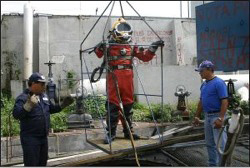 |
 |
 |
 News from Around the Americas | December 2006 News from Around the Americas | December 2006  
Deep Shit: Mexico City's Sewage Divers
 Jo Tuckman - Cyber Diver News Network Jo Tuckman - Cyber Diver News Network


| | Carlos Barrios Orta (C) is one of the divers who maintain Mexico City's 600-mile-long sewer system, clearing out debris so it won't back up into streets. (Mary Jordan/Washington Post) |
Mexico City, Mexico - Julio Cesar Cuc spends his days blindly feeling his way through sewage and occasionally risking his life deep in the bowels of Mexico's capital.

"It's a great job," the city's most experienced sewage diver told me recently just before a dive, his tone betraying only the slightest hint of irony. "It's unusual, it's challenging, it's exciting, and it's a real public service."

That part I buy, especially during the May to September rainy season when emergency underwater plumbing can be the only thing keeping the rivers of sewage flowing through Mexico City's 850 miles of pipes and tunnels - rather than bubbling to the surface or bursting the banks of surface canals.

"Black water" floods still happen here, but without Mr Cuc and his team of sewage divers they would be much more common.

The four-man team spends much of its time fixing the pumps that push sewage out of a sprawling metropolitan area twice the size of London, or pulling out rubbish impeding its progress.

The risks are real, from minor infections to being stabbed with infected syringes. A diver drowned 10 years ago in a cascade unleashed when a pipe he was painstakingly clearing suddenly unblocked.

Mr Cuc's own close shaves include nearly getting sucked into the whirring blades of a pump. But the veteran diver, who was one of the founding members of the team, formed in 1982, prefers to talk about the things he's found, including half a Volkswagen beetle and more than a dozen dead bodies - "I don't know how they get down there, but we have to get them out."

There are industrial divers in other cities from Kuala Lumpur to Stockholm who sometimes work in waste, but Mexico City's are probably the only ones who do nothing else, earning a maximum salary of £400 a month.

Their dives last, Mr Cuc tells me, anything from 10 minutes to three hours, at depths ranging from four to 100 metres.

The preparation is always the same. Like medieval knights, the divers step into impermeable suits designed for the icy waters of the North Sea, hold out their arms for thick gloves to be taped on, and then disappear into a helmet connected to a tube that supplies them with oxygen from a surface tank and allows radio communication.

"I can feel rubbish, lots of it ... plastic bags, bottles ... nothing big today ... " Carlos Barrios gave a running commentary from the deep, his only guide in the dense, dark liquid his sense of touch and what he and his workmates on the other end of the radio remember about this stretch of drain.

Getting waste out of Mexico's capital has always been complicated. The Aztecs had a fleet of canoes to collect it from the city they built here on top of a highland lake system.

The problems really began once the Spaniards arrived. Their grand engineering feat of draining the lakes condemned the generations after them to a never-ending battle to remove not only ever more toxic refuse, but also rainwater which no longer had anywhere to go.

A huge tunnel built in the 17th century provided a partial answer for a time, as did a network of surface canals. But an exploding population combined with the city's alarming rate of subsidence to necessitate a deep drainage system in the 1970s, ranging from 40 to 200 metres below the surface.

This year, work began to extend the network, which is already under strain. But there will still be plenty of work for the proud sewage divers of Mexico City.

SOURCE - Guardian | 
 | |
 |



